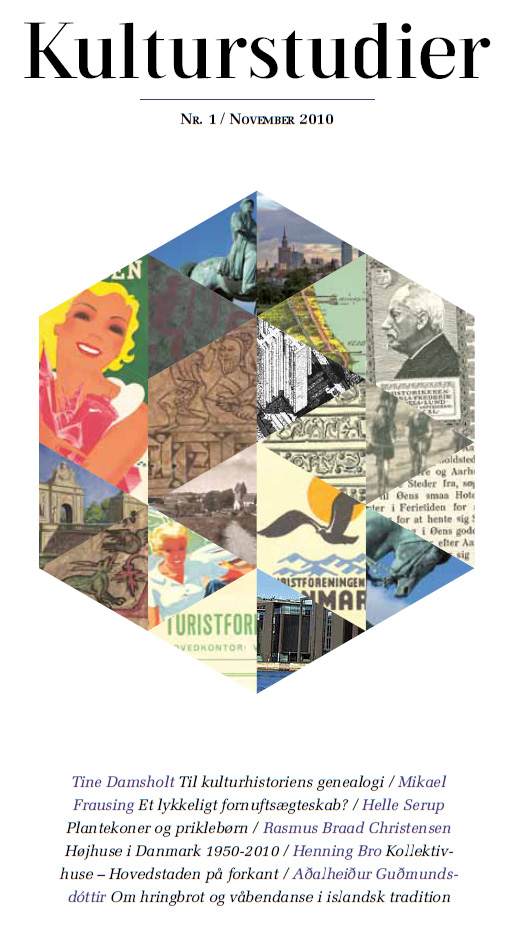Et lykkeligt fornuftsægteskab? Turistforeningen for Danmark mellem hjemstavnsturisme og eksportturisme ca. 1888-1967
DOI:
https://doi.org/10.7146/ks.v1i1.3882Nøgleord:
TurismeResumé
Artiklen baserer sig på undersøgelser af Turistforeningen for Danmarks virke med hovedvægt på perioden 1923-1945. Nedsættelsen af „Udenrigsministeriets Udvalg for Turistpropaganda i Udlandet" i 1934 betød en gennemgribende forandring, hvor staten for første gang involverede sig aktivt i Turistforeningens organisationog arbejde. Turisme blev herved i højere grad opfattet som et eksporterhverv og indrettet efter sit økonomiske indtjeningspotentiale. Hermed lagdes grunden til den organisation og den turismeopfattelse, som kom til at dominere efterkrigstidens danske turisme, mens tidligere, konkurrerende syn på turismen på sigt marginaliseredes. En gennemgang af Turistforeningens brochurer og udgivelser
vil i øvrigt demonstrere, at „Danmark som turistland" repræsenteredes i meget forskellige og konkurrerende diskurser, lige fra en hjemstavnsorientering med vægt på oldtid, landskaber og landbokultur til det „moderne Danmark" med levende byliv, uhøjtidelig harmoni, ungdommelighed og social ansvarlighed. Overordnet betød mellemkrigstiden både i organisation og repræsentation en forskydning af turistarbejdet fra provinsens lokale, folkelige forankring til byernes, primært københavnske, erhvervsinteresser.
Abstract: A Happy Marriage of Convenience?
The Danish National Tourist Organization c.1888-1967
Turistforeningen for Danmark was the Danish National Tourist Organization from 1923-1967. It replaced Den danske Turistforening which dissolved in the turmoil following World War I, and was itself replaced in 1967 by Danmarks Turistråd. This article offers an outline of the development of Turistforeningen for Danmark with a main focus on the interwar-period 1923-1939. Through an analysis of the organization's activities to attract foreign visitors as well as to
„enhance"the travel of Danes within their own country it is shown, how two distinct understandings of „tourism" co-existed, and was balanced against each other, within the organization. Commercial interests, primarily based in Copenhagen and the larger tourist destinations, saw tourism as an economic activity and an „exporting trade" to be exploited in an ever-increasing international tourism
market. On the other hand were the more than 100 local tourist associations, to a large degree non-commercial, which saw tourism as an educational or „ideal" activity, meaning cultural and educational where visiting scenery, prehistoric sites, historic town centres and seeing local customs should teach locals and visitors alike about the region and the nation at large. The basic partnership
between commercial interests and local tourism was maintained throughout the period, but government involvement in 1935 made Turistforeningen for Danmark a state-sponsored organization, dramatically increasing the available funding, but also shifting the balance within the organization in favour of commercial interests.
It also meant noticeable changes in the representations of Denmark through brochures and guidebooks and the beginnings of a modern tourism discourse of 'fairy-tale Denmark', stressing tranquillity, laid-back city-life, social welfare and design. This development was halted by World War II, but though co-operation (as well as organizational debate) persisted throughout the 1950's and 1960's, the commercial and professional understanding of tourism became increasingly dominant, thereby pushing different ways of managing and thinking about tourism to the margins.
Downloads
Publiceret
2010-11-30
Citation/Eksport
Frausing, M. (2010). Et lykkeligt fornuftsægteskab? Turistforeningen for Danmark mellem hjemstavnsturisme og eksportturisme ca. 1888-1967. Kulturstudier, 1(1), 24–52. https://doi.org/10.7146/ks.v1i1.3882
Nummer
Sektion
Artikler
Licens
Tidsskriftet forbeholder sig ret til førsteudgivelsen, mens ophavsretten til artiklen tilfalder forfatteren.
Artikler udgivet af Kulturstudier licenseret under en Creative Commons Navngivelse-IkkeKommerciel-IngenBearbejdelse 4.0 International Licens





